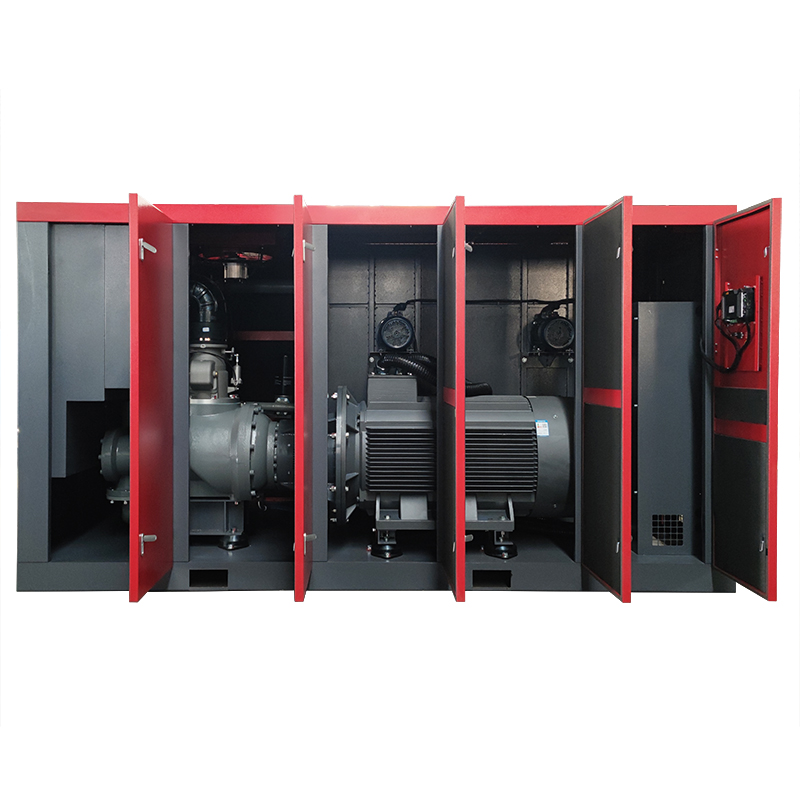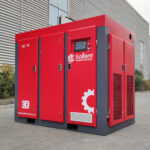1. Overview of Screw Air Compressors
Screw air compressors are positive displacement compressors that rely on the rotation of a pair of intermeshing spiral rotors (male and female rotors) to achieve gas compression. Compared to other types of compressors, screw air compressors offer several advantages:
- High Efficiency and Reliability: Continuous, pulsation-free air supply with stable flow.
- Compact Structure: High-speed operation, small size, and lightweight.
- Low Maintenance Costs: Fewer moving parts, minimal wear, long lifespan.
- Strong Adaptability: Capable of compressing air, natural gas, inert gases, etc., suitable for a wide range of pressures.
- High Automation: Enables unattended operation, reducing labor costs.
2. Working Principle of Screw Air Compressors
The operation of a screw air compressor can be divided into three stages: intake, compression, and exhaust.
(1) Intake Process
- The motor drives the male rotor, and the female rotor synchronously rotates through direct meshing or gears.
- The rotor grooves form new cavity spaces, and gas is drawn in due to the pressure difference.
(2) Compression Process
- As the rotors continue rotating, the inter-tooth volume decreases, compressing the gas.
- Oil Injection Cooling (in oil-injected screw compressors):
- Lubricating oil is injected into the compression chamber to mix with the high-temperature, high-pressure gas, providing cooling, sealing, lubrication, and noise reduction.
- The oil-gas mixture absorbs heat, lowering gas temperature and ensuring efficient compression.
(3) Exhaust Process
- When the inter-tooth volume reaches the exhaust port, the compressed air is discharged.
- Oil-Gas Separation (in oil-injected screw compressors):
- The oil-gas mixture enters an oil-gas separator, where centrifugal force, gravity, and filtration separate the oil.
- The recovered oil is reused, and the compressed air moves to post-processing equipment for further purification.

3. Oil and Gas Flow in Screw Air Compressors
(1) Oil Circuit Flow
- Lubricating Oil Circulation:
- Oil is drawn from the oil separator tank, filtered, and supplied to the compressor.
- Functions: Cooling, sealing, lubrication, noise reduction.
- Oil Cooling:
- High-temperature oil passes through a cooler (air-cooled or water-cooled) before returning to the oil tank.
- Oil Filtration:
- Oil filters remove impurities; high-end models include additional inline filtration for improved oil purity.
(2) Gas Circuit Flow
- Gas Compression: Gas is compressed within the rotor grooves, increasing pressure and temperature.
- Oil-Gas Separation:
- Primary Separation: Centrifugal force separates most oil from the gas.
- Fine Separation: Oil mist is further removed using an oil-gas separation filter.
- Post-Processing (Optional):
- Drying: Refrigerated or adsorption dryers lower air dew points.
- Filtration: Filters remove solid particles, moisture, and oil mist.
- Deodorization: Activated carbon filters eliminate odors for high-purity air applications.
- Compressed Air Output: The treated air is delivered to end-users.
4. Key Components of Screw Air Compressors
Main Components and Their Functions
- Rotors: Core components determining capacity and pressure ratio.
- Synchronization Gears: Ensure precise rotor meshing.
- Bearings: Support rotor rotation and bear radial and axial loads.
- Oil Filter: Removes impurities from lubricating oil.
- Oil Cooler: Reduces high-temperature oil temperature.
- Oil-Gas Separator: Ensures efficient separation of oil and compressed air.
- Intake Valve: Controls the intake volume for flow regulation.
- Exhaust Valve: Manages air discharge, improving system stability.

5. Future Trends in Screw Air Compressors
(1) Energy Efficiency Improvements
- Optimized Rotor Profiles: Enhanced volumetric efficiency and reduced energy consumption.
- Variable Frequency Drive (VFD) Technology: Precise flow control for lower operating costs.
- Optimized Lubrication System: Reduced oil consumption and increased efficiency.
(2) Intelligent Control
- IoT Integration: Enables remote monitoring and fault diagnostics.
- Smart Control Systems: Enhance interaction between compressors and air usage equipment for improved efficiency.
(3) Environmental Upgrades
- Eco-Friendly Lubricants: Reduce environmental impact.
- Improved Oil-Gas Separation: Lower oil mist emissions in exhaust air.
(4) Modular Design
- Integrated Modular Systems: Improve maintenance, allowing easy function expansion and upgrades.
- Users can customize components based on operational needs.
(5) Noise Reduction Optimization
- Structural Enhancements: Advanced noise-reduction designs for quieter operation.
- Upgraded Silencing Systems: Improve industrial workplace comfort.
Conclusion
Screw air compressors, known for their efficiency, stability, and low maintenance, are essential in industrial compressed air applications. Future developments will focus on energy efficiency, intelligence, environmental sustainability, and modularity, ensuring better compressed air solutions across industries.
Sollant Dry Oil-Free Air Compressor – Pure Air, Maximum Efficiency!


